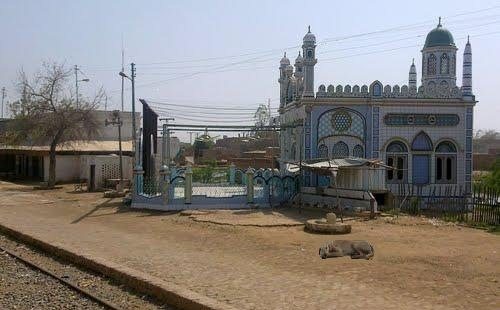Tando Allahyar

Compiled By: Rtn. Gangaram Shamdas Purswani (P.H.F.)
Tando Allahyar (ٽنڊوالهيار, in Sindhi) is a city and capital of Tando Allahyar District located in Sindh, Pakistan.
History
Tando Allahyar was founded by Mir Allahyar Khan Talpur(Mir Clan) in 1709.”Members of Khudabadi Sonara Community living there belong to Tanadai Bradri”
Watayo Faqir’s shrine
The shrine of old Sindhi Oracle, legendary character of folk wisdom and Sufi poet Watayu Faqeer is also situated in Kuba Shareef near Rashidabad, Tando Allahar.”.
1790 fort construction
Tando Allahyar was founded in 1709 when Talpur constructed a mud and clay Fort about 3 kilometres (1.9 mi) from the present day Tando Allahyar town center. The fort was built to provide security for the Mir and the people of the area. It also functioned as a Trading Post. As the township developed around the fort, it was known as “Allahyar Jo Tando” (Allahyar’s Town). The fort is now called “Kacho Qilo”. Some walls, decorated at the time of the Mir remain.
British rule
In 1906, during the British Raj, a railway station was established. It reflected the town’s growing importance as a centre of agriculture and trade. The name of the town changed from “Allahyar Jo Tando” to “Tando Allahyar”. The British Raj took the fort for its official use.
Canal
In 1933, a Canal was constructed. It further increased Tando Allahyar’s importance in agriculture and trade.
Independence
Prior to 1947, the majority of inhabitants of Tando Allahyar were Hindu. The temple of Baba Ramdevji Rama-Pir was a symbol of Hindu–Muslim unity and peaceful co-existence. After Independence of India -Pakistan, many Hindu followers left. Nevertheless, the temple, located in the town centre, remains a popular destination for Hindu Pilgrims.
The predominantly Muslim population supported Muslim Leage and Pakistan Movement. After 1947, the minority Hindus and Sikhs migrated to India while the Muslim refugees from India settled in the Tando Allahyar District.
Ramapir Temple
The Rama Pir Mandir is a temple of Ramdev Pir in Tando Allahyar. Some preliminary reflections related to its History, Architecture & Symbolism. The temple of Rama Pir is one of the third largest pilgrimage sites for the Hindus in Sindh. Every year in Bhadrapada month of Hindu Calendar , here the 3 days Mela is being arranged by Ramapir Sheva Mandli.
Legend
According to a legend, about 150 years ago, a man of Khatri community of Tando Allahyar took a vow that if he was blessed with a son, he will arrange the “Mela” (fair) of Rama Pir in Tando Allahyar Sindh. As the wish of this Khatri community man was fulfilled, he brought an earthen lamp from the original temple of Rama Pir in Rajasthan, India to Tando Allahyar, Sindh, Pakistan and built a temple here. After worshiping to “Shree Ramapir” his wish was fulfilled and then he built this temple. In the mela carrying “Dajja” (flags) in their hands, they recite “Bhajans” whole night sitting outside the city and early in the morning at 5:00AM they hoist “Dajja” at the temple by dancing on the beat of drums and trumpets. Thousands of devotees, including man, women and children, traveled on foot to pay homage to Rama Pir. They had brought flags which were hoisted at the temple. Although Ramdev alias Rama Pir, a Hindu saint of 19th century, was cremated in Rajasthan, but he had come to Tando Allahyar and his devotees had constructed a temple in his memory at the place where he had worshiped as far back as 1800. Since then, a fair is held at the Rama Pir temple by his devotees every year.
Location
Tando Allahyar lies 25 miles (40 km) north east of Hyderabad, on the road between Hyderabad and Mirpurkhas. Tando Allahyar is a railway hub for the Sindh region. Early in the nineteenth century, members of the Bozdar family, a community from the Suleiman Mountains, founded the settlements of Khan Muhammad Bozdar (a nearby village of fifty-two houses), Massu Bozdar and Dhangano Bozdar.
Agriculture
Tando Allahyar is one of Pakistan’s richest agricultural regions. Cash crops like sugarcane, wheat, onion and cottan are cultivated. Mangoes and bananas are also grown. There are sugar mills and some cotton ginning factories.
Religion
Tando Allahyar’s population is predominantly [shia and Sunni Islam]. There is a small Hindu community also exists in the city are mainly they are doing good businesses and on the rural areas mostly Hindu communities are doing cultivation. There are few Shrines are in the city in different area like Bukera Sharif also there is very old Madrasa on the city with the name of Darul Uloom once called as “Saniye Darul Uloom”.
Culture
Tando Allahyar has a rich traditional Sindhi culture. Women may wear a Shalwar Kameez but often wear the traditional dress, the gharara or “parro”. Traditionally, many bangles are worn on the arms. Men wear a Shalwar Kameez distinguished by broader bottoms and a traditional Sindhi style cap. The youth may appear in western styles.
Languages
Sindhi, Siraiki and Urdu, are the main languages spoken. Other languages including Rajisthani (Kaimi Khani) Khanzada, dhatki, Marwari, Balochi Punjabi and Brahui as well some Dravidian languages.
Architecture
Tando Allahyar is a bustling town with mango tree lined streets. Old buildings are topped by chimney like air cooling devices that catch the breeze.